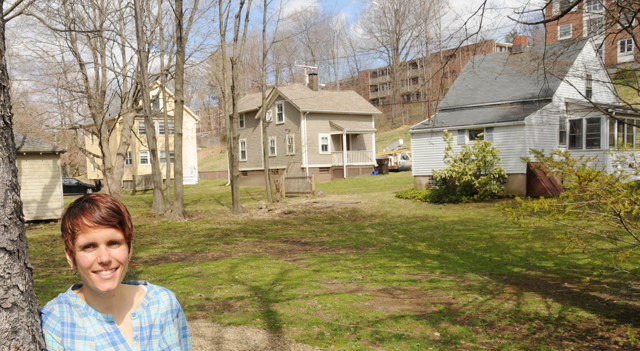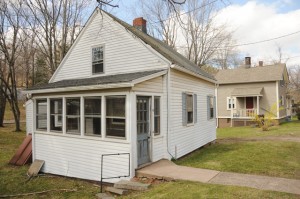5 Questions With . . . Sarah Croucher on Middletown’s Beman Triangle

In this issue of The Wesleyan Connection, we ask 5 Questions of Sarah Croucher, assistant professor of anthropology, assistant professor of archaeology, assistant professor of feminist, gender, and sexuality studies. Croucher will lead an archaeological dig on the site of the Beman Triangle in Middletown on April 28-29. The public is welcome to attend. To view photos of the dig on April 14-15 click here.
Q: Professor Croucher, what exactly is the Beman Triangle and what is its significance to the history of Middletown?
A: The Beman Triangle is the land between Vine Street, Cross Street, and Knowles Ave., where homes have existed since the early 19th century. Local historian Liz Warner has shown that something very important happened here in the mid- to late-19th century. Leverett Beman, son of the first Pastor of the African Methodist Episcopal (AME) Zion Church in Middletown, had the land divided into plots by a surveyor in 1847, and sold these plots off to other African-American families. This seems to be a deliberately planned community; a way that members of the AME Zion Church could become property owners (something that remains hard for many people today), and live as neighbors in a relatively prosperous community. The Beman Triangle is of national importance as very few African-Americans were able to go through a similar community-building process in the mid-nineteenth century, when they still lacked U.S. citizenship and slavery was still legal in many states. Although the houses might not look like much today, the site is an important testament to the lives of the nineteenth century Beman Triangle community.
Q: What do we know already about the AME Zion Church community?
A: There has been some wonderful historical research done on the Beman Triangle community by local historians Liz Warner and Janice Cunningham, as well as Wesleyan alumnus Jesse Nasta as part of his thesis. This work has shown us how active the residents were politically, in ways that are traceable through historical documents. We know that community members were active as abolitionists, in campaigning for political rights, and in the temperance movement. They also fought in the Civil War. The AME Zion Church in Middletown was also one of the first in the country to begin meeting, and the Church was clearly important in tying together the community. Overall this gives us a picture of a vibrant group of individuals who were active in local and national political and social concerns.

Q: What are you hoping to discover in your dig and how will this better inform our understanding of the historical AME Zion Church community?
A: Archaeology provides a very different kind of route to understanding the past than documentary history. We find the kinds of objects that get discarded and lost in the course of everyday life. In this dig, we hope to discover evidence of the kinds of things residents bought and had around the house, as well as artifacts showing what and how they ate, such as plates, bowls, cups, glassware and the like. We might find bottles or jars, which would show the use of local or nationally branded products, and we might find esoteric pieces of bric-a-brac—the kinds of little figurines that people might have used to decorate their homes. This would give us a picture of the daily lives of everyone who lived at the site, and allow us to think about the kinds of choices they made in the mundane details of their lives, and how these relate to the broader context we know about the background of the site.
Q: What is “community archaeology” and why did you decide to follow this model to explore the Beman Triangle?
A: Community archaeology is about collaborative research. It is a process of engaged scholarship in which archaeologists try to cede authority over their excavations and interpretations to stakeholder communities – in this case the AME Zion Church in Middletown. Historical archaeologists often find out that the communities we collaborate with have more interesting questions than scholars do in shaping projects. We continually share with our community partners what is going on, from the questions we formulate to the excavations, lab analysis, and public presentation. Hopefully, the end product is research that is much more engaging to the communities we’re working with, and which ties in to present day interests. It is also usually stronger academically, because by listening and being directed in some of the questions we ask of archaeology, we end up learning more overall. At the moment, the AME Zion Church members I’m working with want us to explore the way in which Beman Triangle residents might have viewed the importance of faith and their vision for the future, as well as issues of gender, and the Underground Railroad. We’ll try to make sure that we use these questions to structure how we analyze our findings from the site and present them to a wider public audience.
Q: Who will participate in the dig?
A: We’ll already dug on April 14 and 15, and we will again on April 28 and 29, weather permitting. The excavators will be students from the “Middletown Materials” class—who are also doing a lot of varied and exciting projects that draw out from the excavations and the history of the site—and volunteers from the AME Zion Church. We will be offering site tours for the public each day that we’re digging, between 1-5 pm. We will also have lots of volunteer opportunities for washing finds. In future years when we are digging, I hope to be able to have more volunteers excavating.

